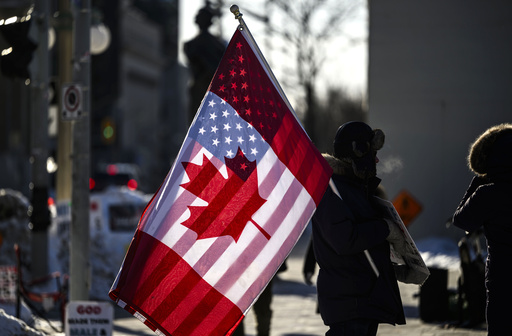
ATLANTA — President Donald Trump has initiated new executive measures imposing tariffs on imports from Canada, China, and Mexico. This development is in line with his campaign pledges but has ignited retaliatory actions that may herald a prolonged trade conflict with significant partners, particularly Canada and Mexico, which are the U.S.’s closest allies.
In contrast to his campaign rhetoric during the 2024 election, where he presented his economic policies as a guaranteed solution to alleviate Americans’ cost of living, Trump is now conceding that these tariffs might lead to increased prices and reduced supplies throughout various markets, a sentiment that many economists have anticipated for some time.
The tariffs target the United States’ three major trading partners. Trump declared a national economic emergency which enacts a 10% duty on all imports from China, accompanied by a 25% tariff on goods from Mexico and Canada. Additionally, energy imports from Canada, such as oil, natural gas, and electricity, will incur a 10% tax. These tariffs are set to take effect on Tuesday.
These increased tariffs will impact an array of products across the U.S. economy, including Canadian oil and lumber, Mexican produce, clothing, liquor, and auto parts, as well as Chinese plastics, textiles, and computer chips. Notably, the executive order does not provide any exceptions for U.S. importers.
The potential repercussions are significant because Canada supplies more than 4.3 million barrels of oil to the U.S. each day, while the overall U.S. consumption hovers around 20 million barrels per day, with domestic production approximately 13.2 million barrels daily, according to the U.S. Energy Information Administration.
Trump’s framing of these tariffs is heavily focused on immigration and drug-related issues. While he has consistently criticized trade agreements and the exodus of manufacturing jobs, his current narrative places blame on these three countries for not adequately controlling drug trafficking, specifically the influx of fentanyl, as well as for allowing unauthorized migration across the U.S. borders.
“It is my duty as president to ensure the safety of all,” Trump asserted on social media, positioning the tariffs as necessary for national security.
In response to Trump’s announcement, both Canada and Mexico swiftly implemented countermeasures. Mexican President Claudia Sheinbaum announced retaliatory tariffs, and Canadian Prime Minister Justin Trudeau indicated he would impose equivalent 25% tariffs on up to $155 billion in U.S. imports. Trudeau called on Canadians to prioritize local products, effectively encouraging a boycott of U.S. goods, while various Canadian provinces plan to eliminate American alcohol brands from government store offerings.
As of now, China has refrained from imposing new tariffs but has warned of “necessary countermeasures” to protect its rights and interests. Additionally, the Chinese Ministry of Commerce conveyed plans to file a complaint with the World Trade Organization regarding the U.S.’s trade practices.
Consumers can expect to feel the impact of these tariffs, even if they do not directly pay them. The financial burden from the tariffs generally falls on the businesses that import the goods, but these costs are likely to be passed down to consumers, contributing to the overall increase in prices come retail.
Gregory Daco, chief economist at EY, estimates that the new tariffs could raise inflation, which had been at an annual rate of 2.9% last December, by an additional 0.4 percentage points during the year. Daco also forecasts that the U.S. economy, which experienced a 2.8% growth in the previous year, may contract by 1.5% this year and possibly 2.1% in 2026.
The Budget Lab at Yale University has projected that these tariffs will effectively reduce the annual purchasing power of the standard American household by $1,000 to $1,200.
The ramifications extend even to products labeled as “made in the U.S.A.,” since this designation might only indicate that the product is assembled in the U.S., incorporating raw materials or components sourced from abroad.
Additionally, energy costs—which influence transportation expenses in the supply chain—are likely to impact consumer prices. Given Canada’s essential role in supplying energy to the U.S., it’s anticipated that gas prices, especially in the Midwest where Canadian crude is refined, could see an uptick.
Trump has since moderated his predictions regarding the consequences for consumers. While he formerly made sweeping proclamations about economic improvements under his leadership, he has recently acknowledged potential “pain” from these tariffs. He expressed on social media, “Will there be some pain? Yes, maybe (and maybe not),” suggesting that despite some hardships, the ultimate goal of revitalizing America’s economy will justify the costs involved.

